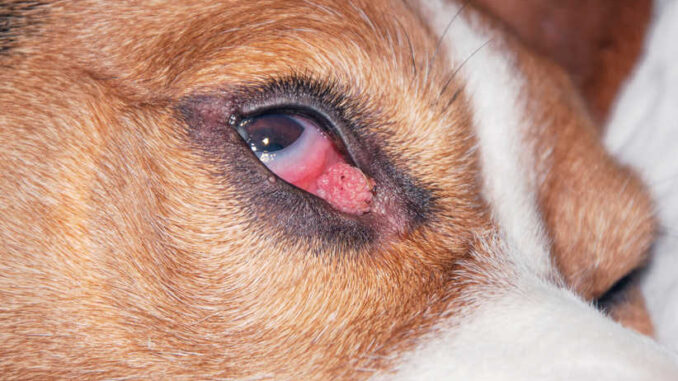
Red lumps in dogs’ eyes can be disconcerting. Fortunately, some of the most common causes of red or pink bumps are benign and treatable. Let’s look at the top 7 reasons your dog may have a red bump in or on his eye so you will know what you can do about them.
Top causes of red bumps on dogs’ eyes (with pictures)
Several common lumps and bumps that appear on dogs’ eyes may be red or pink in color, including the following. Because many of them appear similar or share symptoms, the best way to get a diagnosis is to schedule a visit with your vet.
The most common red bumps on dogs’ eyes are:
1. Cherry eye
In addition to upper and lower eyelids, dogs have a third eyelid known as the nictitating membrane. This membrane is part of the lower eyelid and helps to protect and lubricate the cornea. If the nictitating membrane becomes inflamed, there will be swelling and hyperplasia. This red bump can arise suddenly and irritate your pooch.
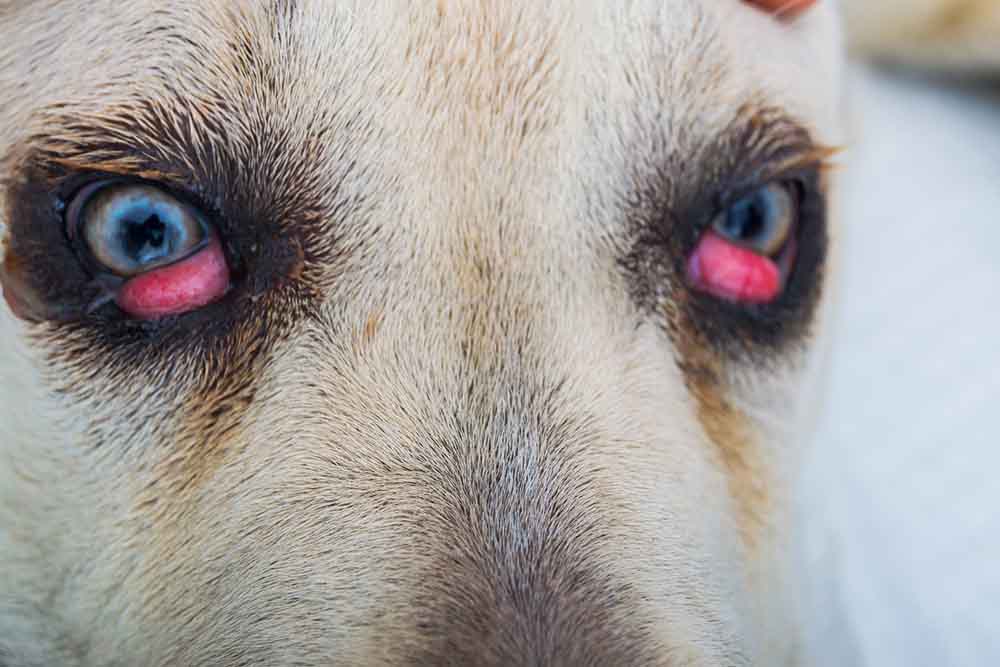
Signs of cherry eye include:
- oval-shaped, red bump in the lower inner corner of the eyelid
- eye irritation
- thick discharge from the eye
- rubbing at eye
- secondary eye infections
Fortunately, cherry eye in dogs is unsightly but usually not painful. While it’s not life-threatening, prompt treatment is necessary to prevent damage to the eye or the lacrimal glands that moisten the corneal surface.
You may be able to temporarily treat cherry eye at home with anti-inflammatory drops, a warm compress, and gentle massage of the prolapsed membrane. Although the membrane may slip back in place, it almost always pops out again. The only way to cure cherry eye is by surgically replacing and suturing the membrane to hold it in place. If your dog’s condition is severe or has been going on for a long time, a second surgery or removal of the nictitating membrane may be necessary.
2. Papilloma/dog warts
Dogs can develop small red or pink tumors in the eyelid known as papillomas or warts. They are caused by the canine papillomavirus, which is transmissible to other dogs but not to other species. These growths are usually benign and may regress on their own in 1-2 months. Signs of dog warts include:
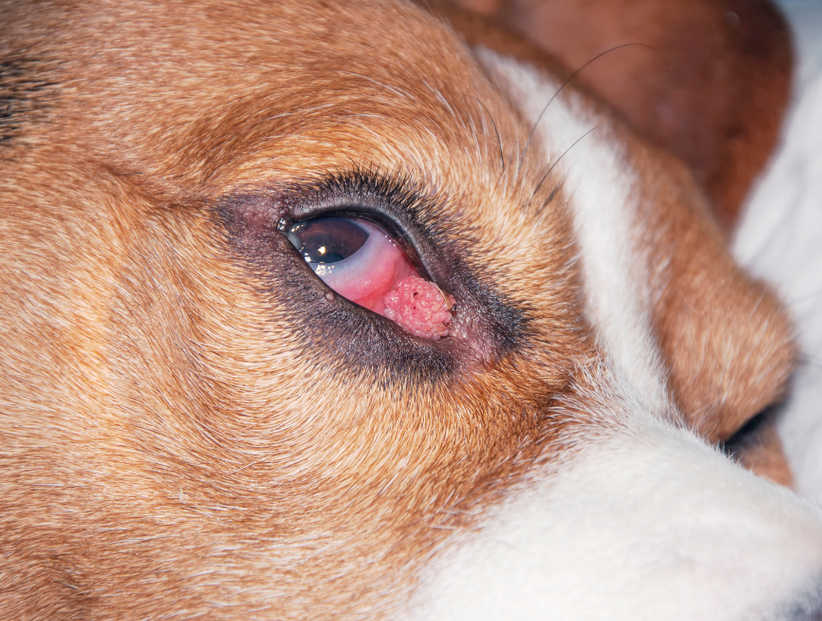
- usually in clusters but can appear alone
- white to pink or light red in color
- cobblestone or cauliflower-like appearance
- may also appear in and around the mouth or between the toes
Papillomas are usually self-limiting, but on rare occasions, they can be a precursor to squamous cell carcinoma. Therefore, it’s always advisable to have your veterinarian check on warts.
Treatment is recommended if the papillomas cause pain, don’t resolve in a month or two, or interfere with eating/chewing/swallowing. In this case, your veterinarian will reduce or remove the growth with electrosurgery, cryosurgery, or traditional surgery.
3. Bug bite or infection
When dogs suffer inflammation from an infection or bug bite near the eye, the affected area may become irritated. The symptoms for these two conditions are similar and include:
- redness/swelling
- hives or red, raised bumps
- swollen face or muzzle
- pawing at the eye/rubbing the eye
- watery or thick eye discharge
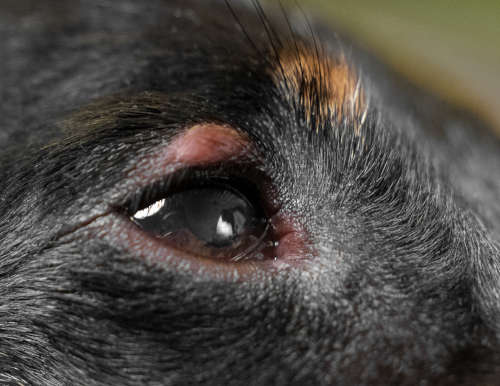
Allergic reactions to insect bites require prompt treatment to reduce swelling, ease your dog’s discomfort, and prevent secondary infections. If your dog has an eye infection, the sooner your veterinarian initiates care, the better the prognosis.
Treatment for insect bites may include antihistamine and anti-inflammatory medications. If the allergic reaction is severe, your dog may also require oxygen or fluid therapy. When dogs have an eye infection, your veterinarian will administer topical or oral antibiotics depending on the nature and severity of the infection.
4. Stye
Styes in dogs are similar to those found in humans. These red bumps occur along the eyelid’s edge when oil glands clog. Signs include:
- red bump at the base of eyelashes
- red/swollen eye
- excessive tearing
- photosensitivity
- scabs/crusting along the edge of eyelids
Below is a picture of a larger red/pink stye on a dog’s eyelid:
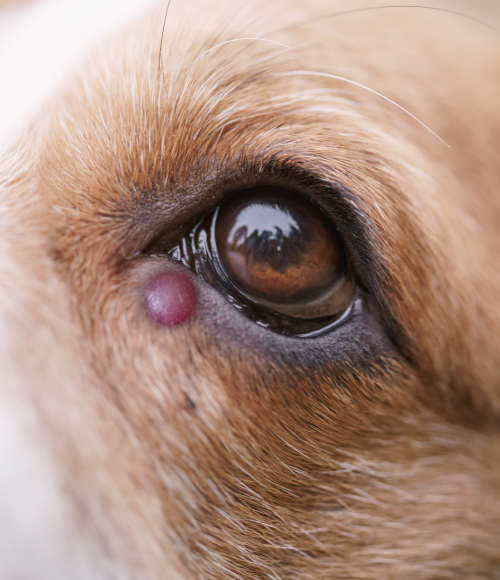
Eye styes can resemble some tumors in dogs, so you will need a veterinarian to diagnose the condition. These lesions tend to be painful and can harbor bacteria, so treatment is warranted to prevent secondary complications.
At home, you can provide initial care for your dog’s stye until you can get him to the vet for diagnosis and treatment.
- use a warm, damp washcloth to clean away eye matter
- gently apply a warm compress to encourage the stye to drain
- wipe away any pus to prevent eye infections
At the clinic, the vet will examine your dog’s eye and run tests to confirm the diagnosis. The treatment of choice for a stye is medical and may include a topical antibiotic with or without a steroid, oral antibiotics, and anti-inflammatory medications. When lesions won’t respond to medical therapy, surgical removal is the next step.
A stye can also be smaller and darker color, as shown in the picture below:
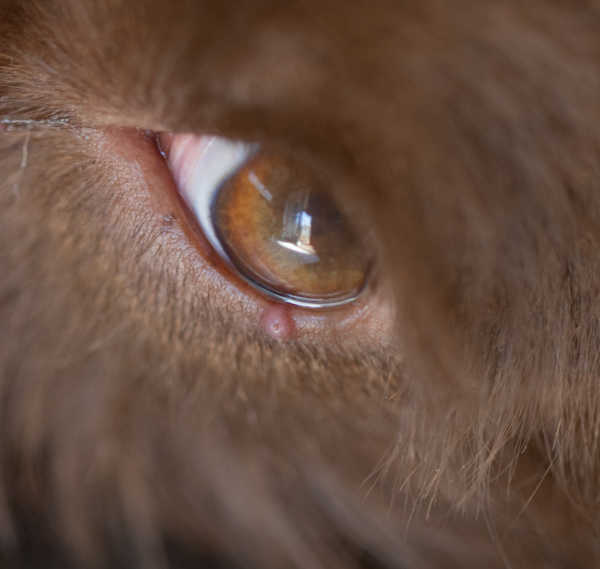
5. Histiocytoma
Usually seen in younger dogs, histiocytomas are benign tumors that are usually not itchy or painful. The growth may arise anywhere, but it’s most common around the head and neck. Histiocytomas present as a hairless, red lump with a smooth skin surface. Although they take 1-4 weeks to develop, they seem to appear suddenly.

Histiocytomas are benign growths, and many of them resolve on their own in a few months. If they grow too rapidly, become ulcerated, or trigger a secondary infection, they can be removed by cryotherapy or traditional surgery. Histiocytoma in Dogs [View more pictures]
6. Meibomian adenoma or adenocarcinoma
Meibomian tumors are some of the most common eyelid tumors in dogs. The meibomian gland is a tiny tiny oil gland that’s located in the upper and lower eyelid. The growths may be benign adenomas or cancerous adenocarcinomas, although the cancerous form is uncommon. These tumors appear pink and lobular. The only way to differentiate between benign and cancerous growths is by biopsy and cytology.
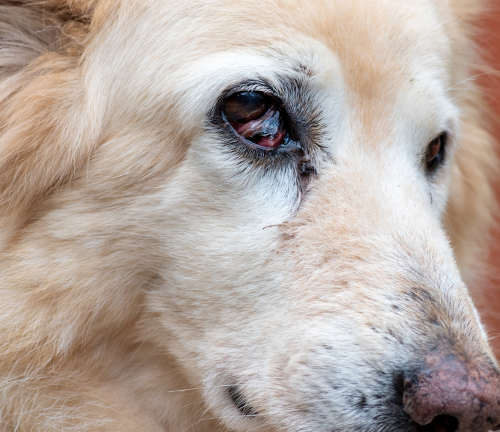
Both types of tumors can be irritating and disfiguring to dogs. While adenomas are benign, they often grow large enough to irritate the cornea. Adenocarcinomas can be locally invasive but don’t usually metastasize to other parts of the body.
Meibomian gland tumors are usually removed surgically to prevent damage to the surrounding tissues.
7. Eyelid tumors
Eyelid tumors in dogs usually appear along the edge of the upper or lower eyelid. Sometimes they are small and hard to notice, but there will be other telltale signs.
- swelling of the eyelid
- protrusion of the eyeball
- inflamed cornea
- conjunctival swelling
- rubbing the eye
- tear staining
- eye infections
Mast cell tumors are one of the most common cancers in dogs. When they present on the eyelid, they’re challenging to treat. The prognosis for the tumor varies depending on the grade or stage of cancer and whether or not it has metastasized.
Surgical removal of mast cell tumors in the eyelid is difficult. Treatment for these growths may include radiation therapy if the cancer hasn’t metastasized or chemotherapy if it has metastasized.
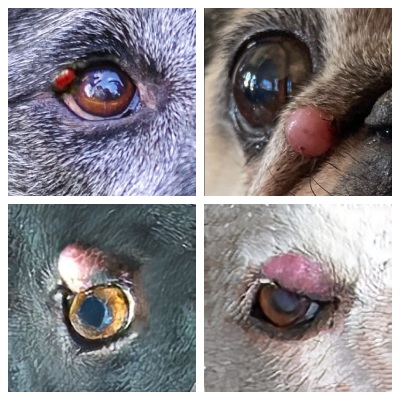
How to find out the type of red bump on your dog’s eye or eyelid
Many of the conditions that cause red bumps on the eye have similar symptoms. Therefore, it’s necessary to visit your veterinarian to get a diagnosis. When you take your pooch to the vet, he will examine the eye and run diagnostic tests that may include the following:
- blood work to assess your dog’s health
- x-rays or ultrasound to check for metastasis
- take a biopsy or fine needle aspirate for cytologic evaluation
The cost of the office exam and diagnostic tests usually runs about $300-350 or more.
What to do if you see a red bump in your dog’s eye?
The most common cause of red bumps in your dog’s eye is cherry eye. If you suspect this condition, you may be able to provide temporary relief by:
- applying a warm compress to the lesion
- treating your pup with anti-inflammatory eye drops
- gently massaging the membrane to return it to its proper place
When the bump doesn’t respond to your efforts, it’s time to take your dog to the veterinarian for diagnosis and treatment.
When to meet your veterinarian
In some circumstances, you may want to try treating your dog at home. This may work for some self-resolving conditions. However, you should take your dog to the veterinarian if:
- the bump doesn’t resolve or respond to treatment
- there’s excessive redness or swelling around the eye
- the eyeball is bulging
- there’s a purulent discharge or weepiness
- your dog has a fever
- your dog has behavioral changes like depression or anorexia
Signs that a red bump may be cancerous or malignant
When your dog has a red bump, it’s difficult to determine whether the lesion is cancerous. However, there are certain signs that often accompany a malignancy.
- rapid growth
- bulging eyeball
- loss of appetite
- lethargy or weakness
- weight loss
- change in color of the bump
If you suspect your dog may have a cancerous bump, schedule an appointment with your veterinarian as soon as possible.
Disclaimer: This website's content is not a substitute for veterinary care. Always consult with your veterinarian for healthcare decisions. Read More.


Be the first to comment